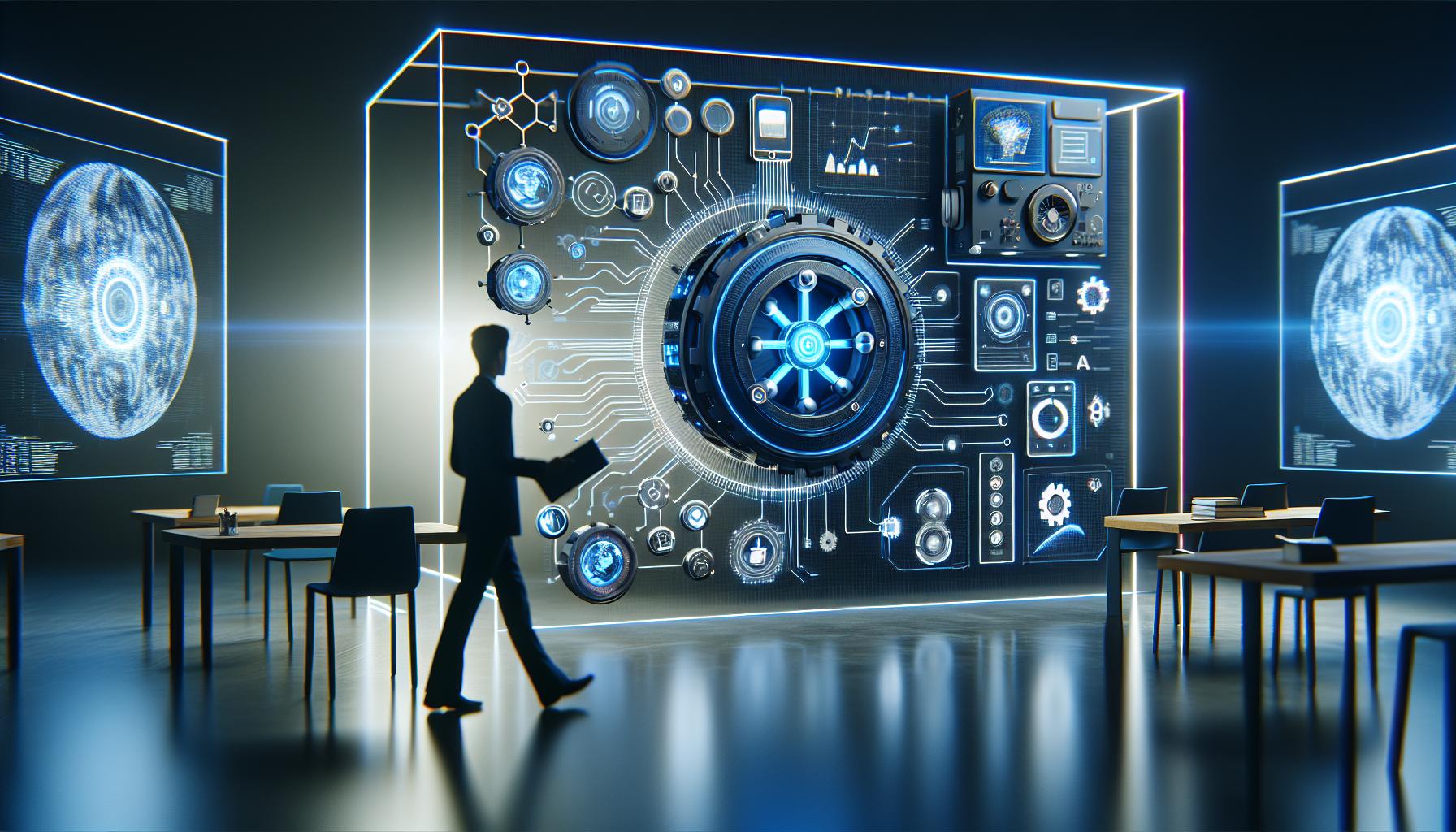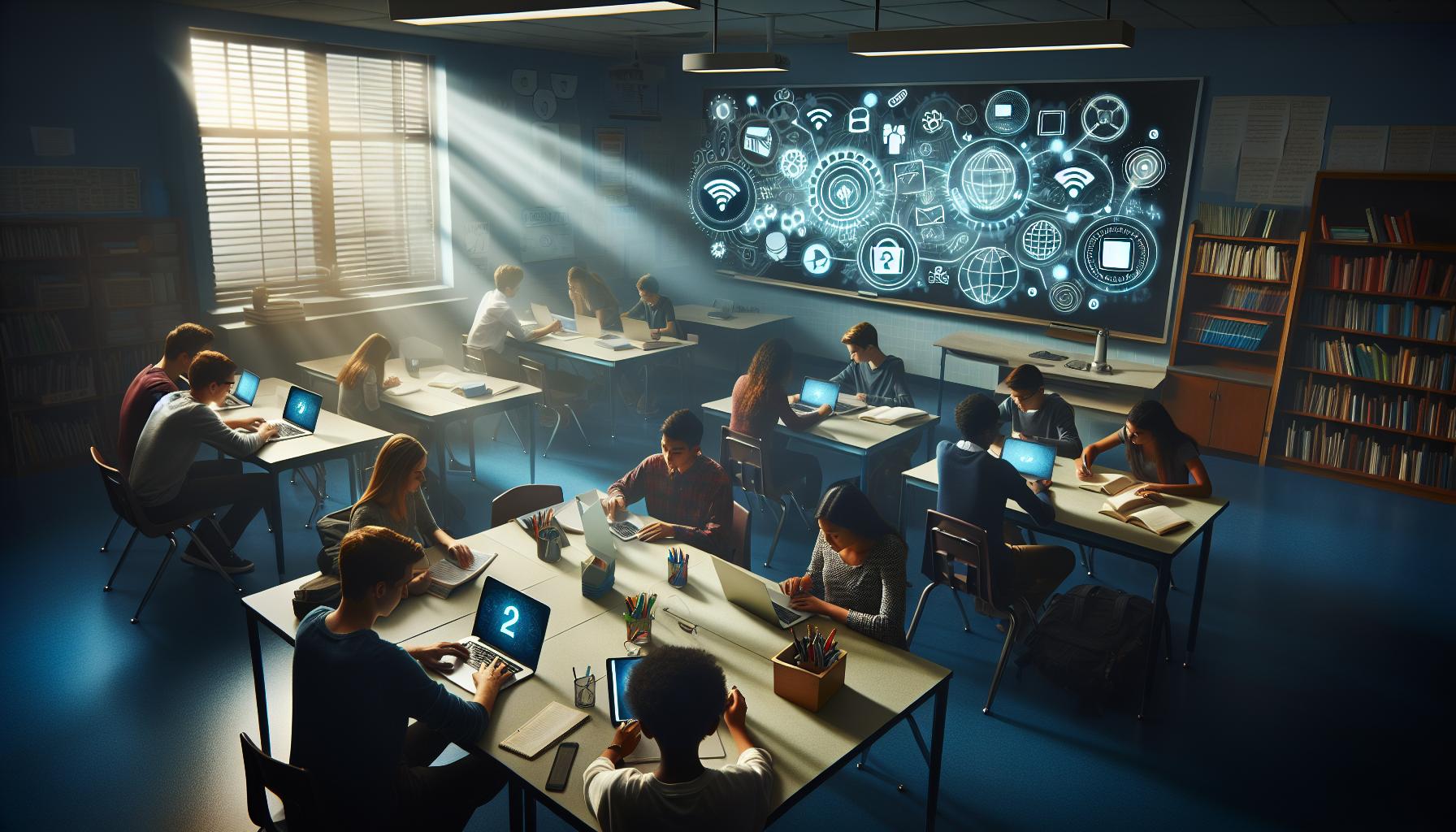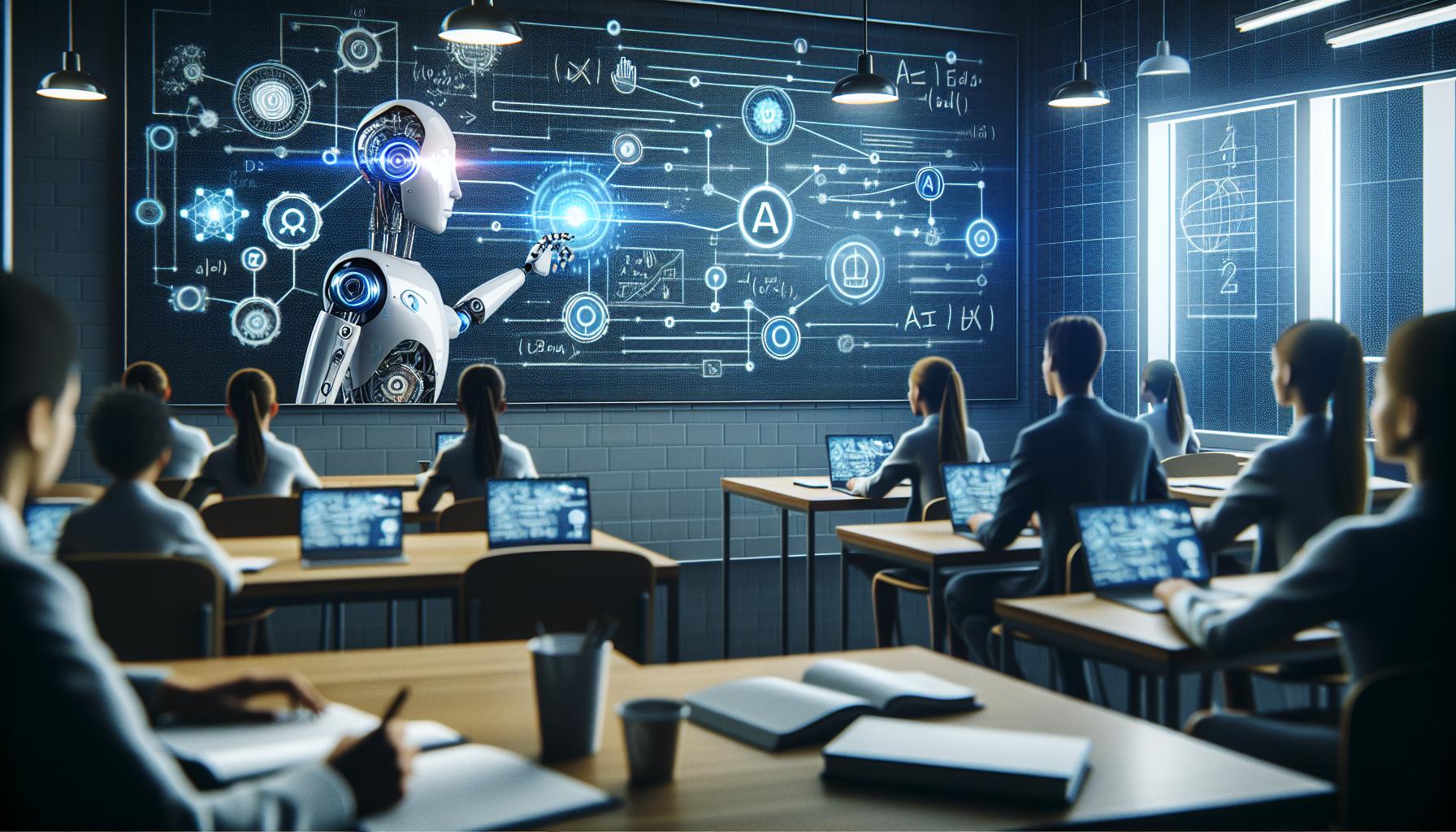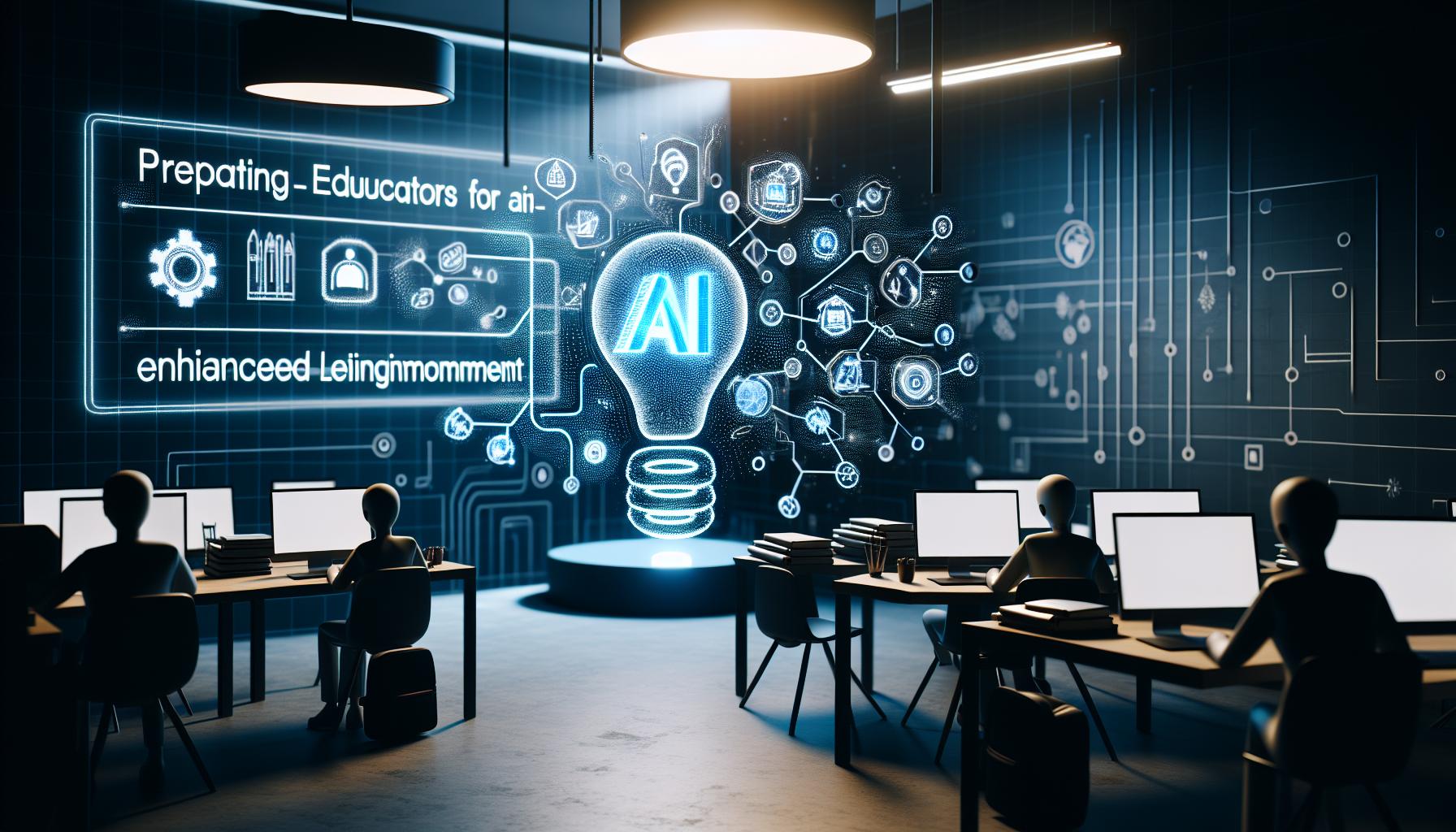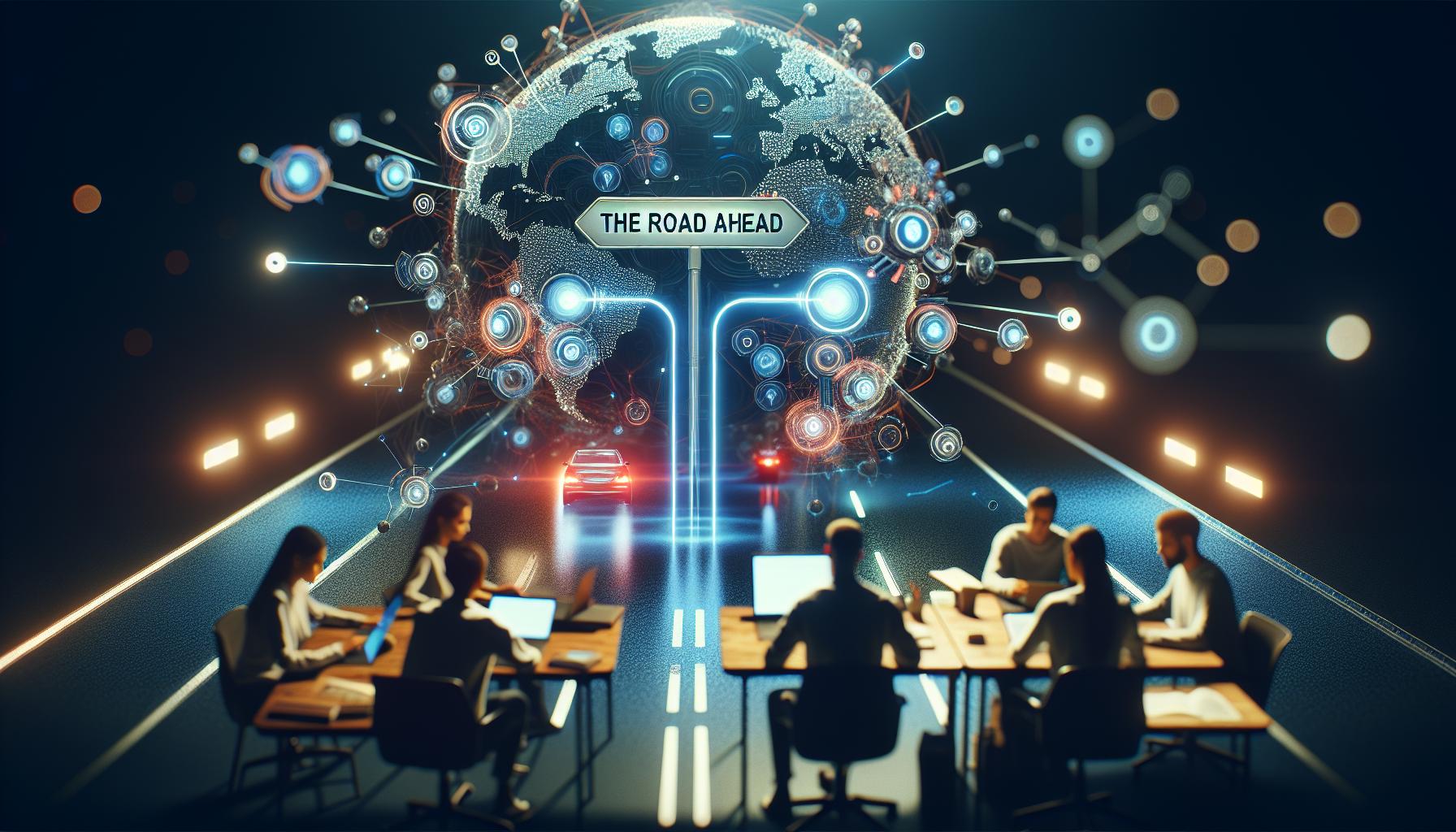As technology rapidly evolves, a critical question looms over the education sector: can artificial intelligence take the place of human educators? This discussion is vital as it explores the balance between innovative learning tools and the irreplaceable value of personal teaching. understanding this dynamic is essential for shaping the future of education in a tech-driven world.
The Role of AI in Shaping Modern Education
The Transformative Potential of AI in Education
As we venture further into the digital age,the question “Can AI replace teachers?” transcends a mere speculation and probes into how technology can be harnessed to enhance learning experiences. With artificial intelligence being integrated into various aspects of education, it promises to reshape traditional teaching methods, making them more efficient and tailored to the needs of individual learners. AI serves not just as a tool but as a catalyst for creating a more personalized and engaging educational environment.One significant way AI influences education is through personalized learning. By analyzing data on a student’s learning patterns and performance, AI systems can adapt educational content to suit their unique needs. For instance, platforms such as DreamBox Learning employ refined algorithms to adjust math lessons in real-time, providing tailored exercises that consider individual strengths and weaknesses. This ability to fine-tune learning experiences ensures that every student has the opportunity to thrive—an approach emphasized in the World Economic Forum’s discussions on leveraging AI in education [[1]].
Moreover, AI can enhance the administrative aspects of education, allowing educators to focus more on teaching rather than routine tasks.Clever systems can automate grading and provide insights into students’ progress, freeing up valuable time for teachers to engage directly with their students. This automation not only improves efficiency but also facilitates a more vibrant classroom environment where teachers can devote their energies to mentorship and inspiration rather than logistics.
Creating Inclusive and Equitable Learning Environments
AI’s role extends beyond efficiency; it is also pivotal in promoting inclusivity within educational systems. By developing tools that cater to diverse learning needs, AI can help bridge the education gap for marginalized communities. For example, the use of accessible learning materials powered by AI can provide opportunities for students with disabilities, ensuring they receive a quality education that meets their needs. It emphasizes the necessity of ethical AI practices that promote fairness and diversity, a point highlighted by educational experts [[2]].
As we engage with the concept of AI in education, it’s crucial to balance its potential benefits with a commitment to ethical implementation. Building AI systems that are not only efficient but also equitable will determine the future trajectory of education. By fostering a collaborative environment where technology supplements traditional teaching methods, we can embrace a future where AI enhances, rather than replaces, the invaluable role of teachers. let us prepare for a landscape where every instructional tool is aligned with the goal of empowering educators and students alike in this technological revolution.
Understanding the Capabilities and Limitations of AI in Teaching
AI: A Promising ally in Education
The integration of artificial intelligence in teaching has opened new avenues for enhancing the educational experience. it can provide tailored learning paths for students, adapting to their unique needs and learning speeds. Such as, AI-driven platforms can analyze a student’s performance in real-time and adjust content delivery accordingly. this capability not only makes learning more engaging but can also lead to improved academic outcomes. With the right approach,AI is poised to complement educators’ efforts rather than wholly replace them.
However, while the potential of AI is extraordinary, it’s crucial to recognize its limitations in the educational context. AI lacks the ability to replicate the human elements of teaching, such as empathy, moral guidance, and social interaction.These are foundational aspects of education that foster a supportive learning environment and nurture critical thinking skills. Moreover, reliance on AI could risk creating a one-size-fits-all approach that undermines individual student needs, especially if the technology is not implemented thoughtfully.
Key Capabilities of AI in Education
AI can leverage vast amounts of data to:
- Personalize Learning: Offer customized resources and activities based on student performance.
- Automate Administrative Tasks: Free up teachers’ time through automated grading and scheduling.
- Provide Real-time Feedback: Enable immediate responses to student inquiries and performance metrics.
Despite these strengths, educators must remain vigilant about the ethical implications of AI usage. As highlighted in discussions about ethical AI frameworks, ensuring equitable access and inclusive practices is vital to prevent widening the educational gap for marginalized students [[1](https://www.weforum.org/stories/2023/06/ethical-ai-future-ready-inclusive-education-system/)].
Understanding the Balance
To maximize the effectiveness of AI in teaching, schools should focus on developing a mixed approach, combining the strengths of AI technologies with the irreplaceable qualities of human educators. This partnership allows teachers to take on more facilitative roles, guiding students through complex concepts while AI manages repetitive tasks. As detailed in the AI Guidance for Schools toolkit, following responsible principles for AI implementation is essential for a accomplished educational conversion [[3](https://www.weforum.org/stories/2024/01/ai-guidance-school-responsible-use-in-education/)].
recognizing both the capabilities and limitations of AI is essential in shaping its role in the classroom.The question of “Can AI Replace Teachers? An Essay on Education’s Future with Tech” emphasizes a future where educators and AI coexist, enhancing the learning landscape rather than overshadowing the teacher-student dynamic.
Personalization in Learning: How AI Tailors Education to Individual Needs
Did you know that personalized learning can enhance student engagement by as much as 50%? With the advent of artificial intelligence in education, tailor-made experiences are not just a futuristic vision—they are becoming a reality. In the context of evolving educational paradigms, leveraging technology to customize learning pathways is transforming how educators deliver knowledge and how students absorb it.
The Role of AI in Customizing Learning Experiences
Artificial intelligence brings forth unprecedented capabilities to analyze vast amounts of data about students’ learning habits, preferences, and performance levels. By employing sophisticated algorithms, AI systems can identify unique learning styles and academic strengths and weaknesses of individual students. This leads to tailored lesson plans that can adapt in real time,ensuring that education is as effective as possible.
For example, platforms like DreamBox and Smart Sparrow apply AI to create dynamic, personalized learning environments that measure progress and adjust content accordingly. This allows students to move at their own pace, providing advanced learners the opportunity to delve deeper into subjects while offering additional resources to those who may struggle.
Practical Applications of AI in Education
The practical implementation of AI technologies can take various forms, ranging from intelligent tutoring systems to advanced analytics that empower teachers in their pedagogical decisions. Here’s a breakdown of some common applications:
| Submission | Description |
|---|---|
| Intelligent Tutoring Systems | AI provides individualized instruction, adapting to each student’s learning pace and style. |
| Learning Analytics | the collection and analysis of data helps educators understand student behaviors and outcomes for better support. |
| Virtual Learning Environments | Personalized online platforms that adjust course materials based on user interactions and performance. |
Challenges and Considerations
While the potential for AI to customize learning is vast, it is indeed not without challenges. Issues such as data privacy, the need for robust infrastructure, and the importance of human oversight are critical considerations that educators must address. Striking a balance between technology and the irreplaceable human elements in teaching is vital.
With the question, “Can AI Replace Teachers?” lingering, it’s essential to recognize that while AI can enhance and personalize learning, it should act as a supplementary tool rather than a complete replacement. The future of education will likely depend on a collaborative relationship where technology enhances the teaching process while educators provide the emotional support and mentorship that students need to thrive.
The Teacher-Student Relationship: Can AI Replicate Human Connection?
the Importance of Human Connection in Education
Artificial intelligence (AI) has made significant strides in various fields, including education. However, as we explore the question of whether AI can replace teachers, it’s essential to consider the fundamental role of human connection in the classroom. The teacher-student relationship goes beyond the mere transfer of knowledge; it encompasses emotional support, mentorship, and the fostering of a safe learning environment. While AI can assist in providing personalized learning experiences, it lacks the empathy and understanding that only human educators can offer.
- Emotional Intelligence: Teachers possess the unique ability to read social cues and provide tailored emotional support to students.
- Mentorship: They guide students through personal challenges, helping them develop resilience and coping strategies.
- Community Building: Strong teacher-student relationships encourage collaboration and a sense of belonging within the classroom.
AI’s Limitations in Replicating Human Interaction
Despite advancements in generative AI technologies, there are profound aspects of the teacher-student dynamic that AI cannot replicate. AI can aggregate data, track progress, and even provide instant feedback on assignments; however, it often lacks the nuanced understanding required to navigate complex emotional landscapes. As an example,a student struggling with anxiety might find a computer programme’s responses lacking in compassion and understanding,while a teacher can offer encouragement and adjust their approach based on the student’s specific circumstances.
Moreover, AI systems can sometimes misinterpret context, leading to a disconnect in communication that could hinder learning. For example, consider two students: one who excels in traditional assessments and another who learns through hands-on experience. A human teacher can adapt their teaching strategies to meet the diverse needs of these students, fostering an inclusive environment that AI lacks the capability to create fully.
Fostering the Human Element: A Balanced Approach
In envisioning the future of education, it becomes clear that the most effective path lies in a partnership between AI and human educators. Teachers can leverage AI tools to ease administrative burdens, allowing them to focus more on cultivating relationships with their students. By integrating AI responsibly, educators can enhance personalized learning experiences while maintaining the essential human connection that supports student growth.
As we contemplate the implications of AI in classrooms, it’s crucial to implement frameworks that ensure ethical and inclusive practices in education. As an example, educators should undergo training on integrating AI technologies effectively, ensuring they complement rather than replace the human aspects of teaching. This approach will foster a more engaged and empowered learning atmosphere, illustrating that while AI is a powerful tool, the heart of education remains a deeply human endeavor.
| Aspect | AI Capability | Human Capability |
|---|---|---|
| emotional Insight | Limited | High |
| Adaptability to Learning Styles | Moderate | High |
| Providing Personalized Feedback | High | High |
| Building Trust and Rapport | None | Essential |
As we navigate the evolving landscape of educational technology, the question, “Can AI replace teachers?”, remains a complex one. While AI can undoubtedly augment teaching methods and enhance learning,it is indeed the teacher-student relationship that serves as the cornerstone of a fruitful educational experience.
Ethical Considerations in AI-Driven Education
The rapid integration of artificial intelligence into educational settings sparks a myriad of ethical considerations that must be critically examined. With AI tools becoming increasingly prevalent in classrooms, educators, students, and policymakers must grapple with the implications of technology on teaching and the learning environment. As we explore the question of whether AI can replace teachers,it’s essential to address the ethical dilemmas that accompany this shift.
Data Privacy Concerns
One of the foremost revolves around data privacy. students’ learning data can provide valuable insights into their educational needs and progress, but this facts frequently enough involves sensitive personal details. The collection and analysis of such data raise significant questions regarding consent and who has access to this information.
- Transparency: Educational institutions must ensure transparency about what data is collected and how it is used. Communication with students and parents is crucial.
- Informed Consent: Schools should seek informed consent from students and parents prior to data collection, helping to establish trust.
- Data Security: Robust measures need to be implemented to protect student data from breaches and misuse.
equity and Accessibility
as AI technologies become mainstream in education, there’s a risk of reinforcing existing inequalities. Access to advanced AI tools can vary significantly between different socioeconomic groups, potentially widening the educational gap.
| Potential Issues | Consequences |
|---|---|
| Lack of Access | Students in underserved communities may miss out on personalized learning experiences. |
| Digital Literacy | Not all students are equipped with the necessary digital skills to navigate AI tools effectively. |
| Bias in Algorithms | The risk of AI systems perpetuating biases leads to unequal educational outcomes. |
Teacher-Student Relationship Dynamics
The introduction of AI in classrooms also presents challenges to the traditional teacher-student dynamic. While AI can offer tailored learning experiences, it cannot replicate the emotional intelligence, mentorship, and interpersonal relationships that human educators provide. Maintaining a balance between technological assistance and the invaluable human aspects of teaching is crucial for fostering a positive learning environment.
Practical steps, such as integrating AI as a complementary tool rather than a replacement for teachers, can definitely help navigate these dynamics. educators should focus on leveraging AI to enhance their teaching strategies while preserving the essential human connections that underpin student motivation and engagement.
Navigating these complex ethical considerations will be imperative as we probe deeper into the future of education with technology. The critical discourse surrounding the question, “Can AI Replace Teachers? An Essay on Education’s Future with Tech,” not only explores the possibilities offered by AI but also emphasizes the ethical frameworks necessary to utilize these innovations responsibly.
Bridging the Digital Divide: Access to Technology in Classrooms
The rapid integration of technology into education presents both opportunities and challenges. One of the most pressing issues is ensuring equitable access to the essential tools that facilitate learning. As highlighted in the discourse on the future of education in Can AI Replace Teachers? An Essay on Education’s Future with Tech, bridging the digital divide is not just about providing devices; it’s about creating an inclusive environment where all students can thrive.
Understanding the Digital Divide
The digital divide refers to the gap between individuals who have access to modern information and communication technology and those who do not. This disparity significantly affects students, especially in low-income areas.According to a Pew Research Center survey, a substantial number of U.S. students lacked reliable access to the internet or a computer at home, which inhibits their ability to complete homework and participate in remote learning initiatives, especially during crises like the COVID-19 pandemic [3].
Practical Steps to Bridge the Gap
Schools and policymakers must implement strategies that foster equitable access to technology. Here are some actionable steps to consider:
- Provide Subsidized Internet Access: Collaborate with local internet service providers to offer low-cost or free internet access to families in need.
- Distribute Devices: Initiate programs to distribute laptops and tablets to students who lack them at home, ensuring they possess the necessary tools for modern learning.
- Encourage Partnerships: Work with community organizations and local businesses to create technology hubs where students can access the internet and digital resources.
- Integrate Tech Training: Offer training programs for both students and parents to enhance digital literacy, empowering them to utilize technology effectively.
real-World Examples
Several school districts have begun to make strides in bridging the digital divide. for instance, during the pandemic, countless initiatives sprang up to deliver devices and internet access to underserved communities. Schools partnered with nonprofits to provide mobile hotspots and organized “wifi buses” that traveled to neighborhoods to allow students to connect safely. These efforts not only facilitated continued learning during lockdowns but also laid the groundwork for lasting digital education strategies in the future.
By addressing the digital divide, we can ensure that the promising future of AI and technology in education, as discussed in Can AI Replace Teachers? An Essay on Education’s Future with Tech, is accessible to every student, paving the way for a more equitable and effective learning environment.
The Future Classroom: Blending Traditional Teaching with AI Innovations
Did you know that by 2030, it’s estimated that nearly half of all jobs could be automated, including roles in education? As the conversation around “Can AI Replace Teachers? An Essay on Education’s Future with Tech” evolves, it has become increasingly evident that the classroom of tomorrow will not resemble its predecessors. Traditional teaching methods will not simply fade away; instead, they will coalesce with cutting-edge technology to create a hybrid educational environment where both educators and AI tools play critical roles.
personalized Learning Experiences
one of the most exciting capabilities of AI technology is its ability to deliver personalized learning experiences tailored to each student’s needs. Through adaptive learning platforms, AI can assess a student’s strengths and weaknesses and customize educational materials accordingly. For example, an AI-driven tool could identify a student struggling with algebra concepts and provide focused resources and practice problems to improve their understanding.This kind of targeted approach not only enhances individual learning but also frees up teachers to concentrate on more complex interpersonal aspects of teaching, such as mentoring and engagement.
- Blended Learning Modules: Utilizing both in-person and online resources, teachers can leverage AI to enhance interactive lessons.
- Data-Driven Insights: AI can analyze performance data, helping educators identify trends and adapt their strategies to meet classroom needs.
- Engagement Through Gamification: AI can integrate gamified elements into learning, making lessons more engaging and enjoyable.
Enhancing Teacher Roles
While the narrative often focuses on AI’s potential to replace teachers, it’s vital to shift the emphasis to how these innovations can support educators.By automating routine administrative tasks, such as grading or attendance tracking, AI systems allow teachers to invest more time in developing deeper relationships with their students.
Real-World Implementation
A real-life application of this concept can be seen in schools that have implemented AI-assisted platforms like Duolingo for language learning. In these environments, the AI tool can help students with vocabulary and grammar, leaving the instructor free to facilitate conversation practices and cultural discussions. This collaborative effort not only fosters a richer learning experience but also highlights the indispensable role of teachers in nurturing critical thinking and emotional intelligence.
| AI Functionality | Teacher’s Role |
|---|---|
| Automated Grading | Providing feedback and clarification on assignments |
| Data Analysis of Student Progress | Adapting lesson plans based on performance insights |
| Interactive Learning Activities | Fostering discussions and critical thought |
As we envision the future of education, it becomes clear that rather than replacing teachers, the integration of AI innovations will augment traditional teaching methods. This partnership could not only elevate the learning experience but also prepare students for the complexities of an increasingly tech-driven world. “Can AI Replace Teachers? An Essay on Education’s Future with Tech” serves as a crucial discourse by highlighting the collaborative evolution of teaching, making it essential for educators and students alike to embrace this change.
Preparing Educators for an AI-Enhanced Learning environment
Embracing a New Era of Educational Excellence
As technology continues to reshape our world, the role of educators is evolving in unprecedented ways. The integration of AI into educational environments presents a unique opportunity for teachers to enhance their instructional methods, rather than fearing replacement. to successfully navigate this transformation, it is indeed essential to equip educators with the tools and knowledge needed to thrive in an AI-enhanced learning environment.
Strategies for Educator Readiness
To prepare educators for the integration of AI into their teaching practices,a multifaceted approach is necessary. Here are some actionable strategies that can facilitate a smoother transition:
- Professional Development Programs: Regular training sessions that focus on the use of AI tools,data literacy,and technology integration should be prioritized.
- Collaborative Learning Communities: Establishing networks where educators can share experiences and insights about AI applications can foster innovation and support.
- curriculum Redesign: Involving teachers in the process of updating curricula to include AI literacy ensures that they are both comfortable and learned about the technologies being used in their classrooms.
- Pedagogical Strategies: training on how to blend traditional teaching methods with AI functionalities, like adaptive learning and personalized feedback, can help teachers maintain their crucial role in education.
Real-World Examples of Effective Preparation
Several educational institutions have set inspiring examples by integrating AI-based technologies in their professional development initiatives. As an example, in a program implemented by the University of Michigan, educators participated in AI literacy workshops aimed at improving critical thinking and problem-solving skills among students. The results showcased not only enhanced student engagement but also a renewed confidence among teachers in utilizing these advanced tools.
| Institution | Program Focus | Outcomes |
|---|---|---|
| University of Michigan | AI Literacy Workshops | Increased engagement and enhanced educator confidence |
| Stanford University | AI-Driven Pedagogy | Improved teaching strategies and student performance |
By engaging educators in continuous learning and providing support, we can effectively leverage AI’s potential while reinforcing the irreplaceable human touch that teachers offer. Cultivating an educational landscape where AI enhances teaching—rather than replacing it—is vital for creating a future-ready generation of learners. Through these preparations, the essential question of “Can AI Replace Teachers? An Essay on Education’s Future with Tech” transitions from a concern to a collaborative exploration of possibilities.
Evaluating Learning Outcomes: Measuring the Impact of AI on Education
The Transformative Role of AI in Assessing Educational Impact
In an era where digital transformation is pervasive, the potential of artificial intelligence to shape educational outcomes is becoming increasingly evident. Schools and educational institutions are beginning to leverage AI tools to evaluate learning outcomes effectively and enhance the overall teaching experience. By analyzing vast amounts of data, AI can provide insights that were previously unattainable, paving the way for more personalized learning experiences.
Benefits of AI in Evaluating Learning Outcomes
- Data-Driven Insights: AI can aggregate and analyze student performance data, providing educators with real-time insights into individual learning patterns and outcomes.
- Personalization of Learning: By identifying areas where students excel or struggle, AI enables tailored educational strategies that cater to diverse learning needs.
- Efficiency in Assessment: Automated grading systems facilitate instantaneous feedback, allowing students to understand their progress without delays.
- Identifying Trends: AI can detect broader trends in learning effectiveness,helping institutions adjust curricula and teaching methods accordingly.
Measuring Impact Effectively through AI Tools
The integration of AI in education goes beyond mere assessment; it represents a fundamental shift in how learning outcomes are measured. as a notable example, tools like adaptive learning technology use algorithms to cater to students’ learning paces, adjusting material difficulty and types of questions in real-time. These adaptive systems can significantly influence overall educational success as they align learning experiences specifically with student needs.
To illustrate the transformative effect of AI on education, consider the following example of a school utilizing an AI-driven platform:
| Feature | Description | Measured outcome |
|---|---|---|
| Personalized Learning Plans | AI creates customized paths based on student performance | Increased engagement and improved performance metrics |
| Predictive Analytics | Identifies at-risk students and suggests interventions | Decreased dropout rates and improved retention |
| Instant Feedback Systems | Offers real-time assessments during activities | Higher test scores and accelerated learning cycles |
As we explore the role of AI in education through this insightful lens, it becomes clear that while AI cannot wholly replace teachers, it can significantly enhance their ability to measure and improve learning outcomes. By utilizing data and analytics effectively, educators can foster an environment that not only embraces technological advancement but also prioritizes individual student needs and skills development in light of the shifting paradigms in education’s future with tech.
The Road Ahead: imagining a Collaborative Future for AI and Teachers
The Integration of AI in Education
In an era where technological advances are reshaping every facet of our lives,education stands at the forefront of this transformation. The potential for Artificial intelligence (AI) to enhance learning environments is immense, and rather than viewing AI as a replacement for teachers, it should be seen as a powerful ally. AI tools can facilitate personalized learning experiences, where students receive tailored feedback and resources that cater to their individual learning paces and styles. This collaborative approach not only maximizes student engagement but also allows educators to focus on fostering critical thinking and interpersonal skills.
Creating Value through Collaboration
The future of education will likely revolve around a synergistic relationship between teachers and AI tools. Imagine classrooms where AI systems manage routine tasks such as grading and administrative paperwork,freeing up teachers to devote more time to direct student interactions. This shift can enhance the educational experience by allowing educators to engage in deeper discussions, mentor students more effectively, and nurture creative projects. As highlighted in the discussion from ‘Can AI Replace Teachers? An essay on Education’s Future with Tech’, the role of teachers will evolve into guides and facilitators of learning, leveraging AI insights to inform their instructional strategies.
Practical Steps for Integration
To effectively integrate AI technologies into the classroom,schools and educators can undertake several actionable steps:
- Professional Development: Offer training sessions for teachers to familiarize them with AI tools and techniques that can enhance their teaching methods.
- Curriculum Design: Incorporate AI technologies in lesson plans, using AI-generated assessments to inform and tailor future instruction.
- Continuous Assessment: Utilize AI for real-time feedback on student performance,enabling educators to adjust their approaches as needed.
Real-World Examples of AI in Education
Numerous educational institutions are already experimenting with AI to improve learning outcomes. As a notable example, some universities have implemented AI-powered chatbots to connect students with resources instantly, improving accessibility to academic support. additionally, platforms like Duolingo use AI algorithms to create a personalized language learning experience, helping users learn at their own pace, which exemplifies how AI can foster collaboration in the learning process.
| AI Tool | Purpose | Example Use |
|---|---|---|
| Chatbots | Student Support | Answering FAQs and guiding resources |
| Adaptive Learning Platforms | Personalized Learning | Tailoring assessments and learning paths |
| AI Graders | Efficiency in Grading | Automating quizzes and assignments scoring |
As we navigate this educational evolution,embracing a mindset that values partnership between teachers and technology will be crucial. The road ahead is not about replacing educators but rather empowering them to thrive in a tech-enhanced landscape, ultimately leading to richer learning experiences for students.
Key Takeaways
while the integration of AI into education holds considerable promise, the notion that it can fully replace teachers is overly simplistic. AI can significantly enhance educational experiences by personalizing learning, providing real-time feedback, and fostering engagement. However, the irreplaceable human elements of empathy, motivation, and moral guidance remain central to the learning process. As we navigate this dynamic landscape, it is indeed crucial to implement AI technologies responsibly, ensuring equitable access and addressing ethical concerns such as data privacy. Continuous dialog among educators, policymakers, and technologists will be vital to harness the full potential of AI in education while safeguarding the essential human connections that define teaching and learning. For those interested in delving deeper into the future of education with technology,exploring case studies and ongoing research will provide valuable insights into best practices and innovations shaping this transformative era.


